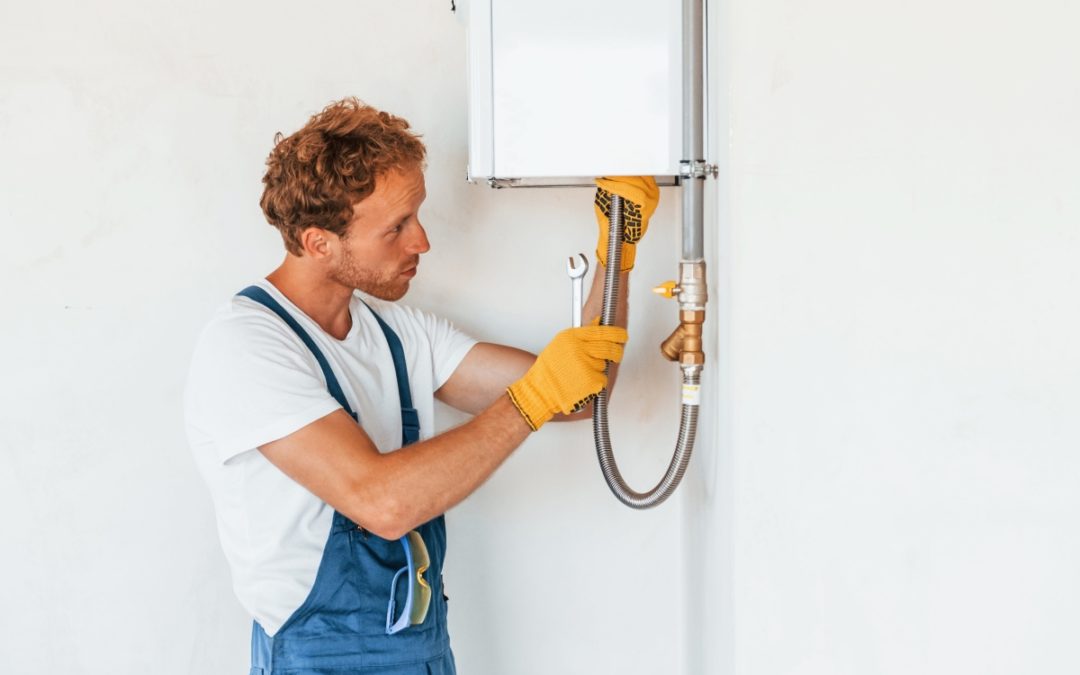Hot water heaters are one of the many fixtures in your home that you can use every day without fully knowing how it works. The core functions of water heaters are easy to understand but with lots of pieces and multiple types, it can be hard to remember the details.
Your hot water heater could have a tank or be tankless, it could be powered by gas or electricity, either way it’s getting hot water into your home.
Your water heater starts by drawing in cold water. When a sensor is activated, an energy source begins heating the water inside the unit. As the water heats up it rises to the top of the tank and is transported through pipes to the rest of the home.
This process varies based on what kind of water heater you have.
Types of Hot Water Heaters
There are two main types of hot water heaters that people use in their homes – tank or tankless.
Tank water heaters are the traditional choice for a water heater. These heaters hold water in an insulated tank and as you turn on hot water in your home, the tank heats up water and sends it your way.
These tank water heaters typically have enough warm water ready for daily duties like dishwashing or showers. However, you may have experienced times when your water heater can’t keep up, like when multiple members of your household use up all the hot water. Who doesn’t hate a cold shower?
A newer, more efficient model of hot water heater has been introduced to meet those challenges.
Tankless hot water heaters quickly heat water and distribute it around your home, instead of storing it in a tank. Cold water is pulled directly into your heater and a sensor activates either a gas-fire burner or electricity source to heat the water inside. Your hot water then travels through your pipes to whichever faucet or appliance is being used.
The tankless heater quickly heats small portions of water, giving you an unlimited supply of hot water around your home.
How Does the Water Get Hot?
Water heaters typically use one of two heat sources. Your heater will either run using a gas-fire burner or an electricity source. An electric heater can be located outside or inside your tank, while a gas burner will always be located at the bottom of the unit.
A gas powered water heater typically has a pilot light that continuously burns. The larger burner is ignited by the pilot light whenever hot water is needed. The gas used to run these hot water heaters is either cycled out of your home by a blower or atmospheric vent.
An electric water heater typically has an electric heating element located inside of the tank. This converts the electric energy into heat and warms the water within your tank.
Both of these heating sources work in conjunction with other components to heat water for your home.
Parts of a Hot Water Heater
Your water heater isn’t just a tank and a heating source, there are multiple essential pieces that are needed to heat your water. Most units include:
Tank: An insulated cylinder where the hot water is heated and stored. For tankless heaters, there is usually a smaller metal rectangle where the water passes through as it is warmed up.
Dip Tube: A narrow tube that runs through your water tank and distributes new water in the bottom. When your hot water rises to the top of the tank and begins running through your pipes, new cool water enters through the dip tube to be heated.
Shut-off Valve: This prevents new water from entering your tank when it’s too full.
Heat-out Pipe: The pipe where hot water exits through the top of the water heater and then goes into other hot water pipes around the house.
Thermostat: Your thermostat monitors the water temperature and ensures the water does not become too hot or too cold. Most tanks are kept anywhere from 120 to 180 degrees fahrenheit. When the water needs to be warmed, the thermostat is what signals the heating mechanism.
Heating Mechanism: Your water heater will have either a top and bottom electric heating element or a gas burner located at the base of the water heater.
Drain Valve: This valve makes it easy to drain your tank when repairs are needed or the unit is being moved. It can also be used if sediment needs to be drained from the water heater.
Pressure Relief Valve: With all of the hot air and water that passes through and sits inside your hot water heater, safe pressure levels are essential. Your pressure relief valve is used to let off some pressure whenever levels creep too high.
Sacrificial Anode Rod: A long rod runs through your water tank to attract things such as iron and limestone that corrode the walls of your tank. The rod corrodes in its place, keeping your tank in better shape. Most anode rods are made of magnesium and aluminum.
What Do I Do If My Hot Water Stops?
Heating water for your home sounds simple at first but things start to complicate as you account for all the pieces needed for each water heater. If something seems off with your water heater, it’s very difficult to fix on your own.
Nobody likes it when the hot water stops and putting off repairs will only separate you from warm showers and clean laundry for even longer.
Mike Wilson Plumbing specializes in water heater plumbing. We offer Chesterfield and Midlothian homeowners a flat rate and upfront pricing for our quick and comprehensive repairs. We can even install and replace water heaters when it’s time for your old one to retire.

